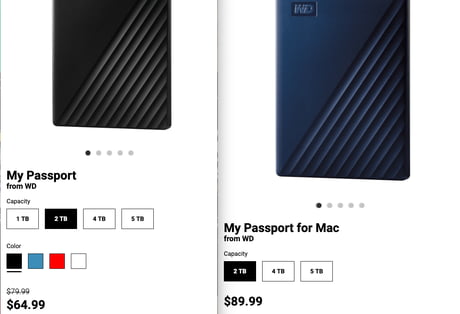
- #My passport ultra reformat for mac mac os#
- #My passport ultra reformat for mac install#
- #My passport ultra reformat for mac software#
- #My passport ultra reformat for mac plus#
You can also click on a partition, give it a name and select the format.

You can use the breakpoint to change the size of the partitions by moving it up or down. Now, just below, you’ll see a visual representation of the partitions. To create a partition, select the hard drive from the left column and click the Partition tab.įrom the drop-down below Partition Layout, select the number of partitions you want.
#My passport ultra reformat for mac mac os#
The other one, for Time Machine backups, will be in Mac OS Extended (Journaled) format. I might need to use the hard drive with Windows computers so I’m going to format one of the partitions as MS-DOS (FAT), fully aware of its limitations. I’m planning on using my hard drive for both Time Machine backups and to carry media files around. Related: Check out our Ultimate Guide to OS X Yosemite. In a couple of seconds, you’ll have an OS X ready hard drive to go. Now, from the left column select 1 TB WD My Passport (or whatever your hard drive name is), and click on the Erase tab.įrom here, in Format, select Mac OS Extended (Journaled), give it a name if you want, and click Erase. You can also find it in Utilities folder in Applications. Press Enter and Disk Utility will launch.
#My passport ultra reformat for mac plus#
Plus you can’t make partitions bigger than 2 TB or move files larger than 4 GB around.įirst, connect the external hard drive, bring up Spotlight Search by using the keyboard shortcut Cmd + Space and type in Disk Utility. But here you won’t get great support for Time Machine. If you’re like me who also needs to use at least a part of the hard drive from Windows PCs, you’ll need to choose MS-DOS (FAT) format. If you’re only going to use the external hard drive with Macs or you want to use it for Time Machine backups, format it in Mac OS Extended (Journaled). Much like my WD My Passport Ultra, most external hard drives out there are customized to work with Windows, not OS X.

If you experience the same issue, your only recourse is to reformat it in one of two formats. Disk Utility showed that it was formatted to MS-DOS (FAT) but I’m pretty sure it would have been NTFS instead. When I first got the hard drive, I wasn’t able to copy anything over to it (but I was able to copy from it). Why You Need to Re-Format the External Hard Drive If you’re only going to be using the hard drive on a Mac, I recommend you stick with Journaled. So to get it running, what we’ll need to do is format it in Journaled format, which is OS X only format or MS-DOS (FAT), which means it will run with both OS X and Windows. These hard drives are customized to run well on Windows (as you’d expect), and they don’t run well with OS X. Turns out, it just wasn’t in the right format.
#My passport ultra reformat for mac software#
Yes, it had some software specifically made for OS X on it, but even that didn’t help. Otherwise, it will be deleted.When I bought the WD My Passport Ultra drive, I was surprised to see that it didn’t support OS X out of the box. Important: Make sure to back up any important data on the drive.
#My passport ultra reformat for mac install#

The new WD FAT32 Formatter v2.0 will copy all the new WDxxxx.bin files to the C:\Program Files\Western Digital Corp\WD FAT32 Formatter\Images folder.Next, double-click on the ExtFAT32v2.0.msi file to install the new WD FAT32 Formatter version 2.0 on your system.This will remove all WDxxxx.bin files from the C:\WINDOWS\system32 directory.



 0 kommentar(er)
0 kommentar(er)
